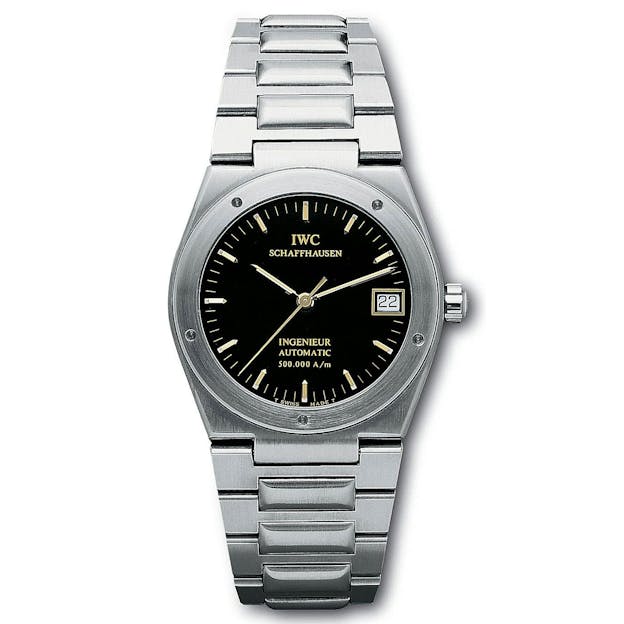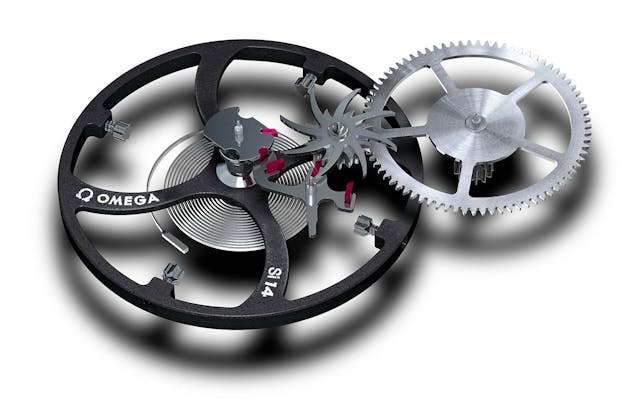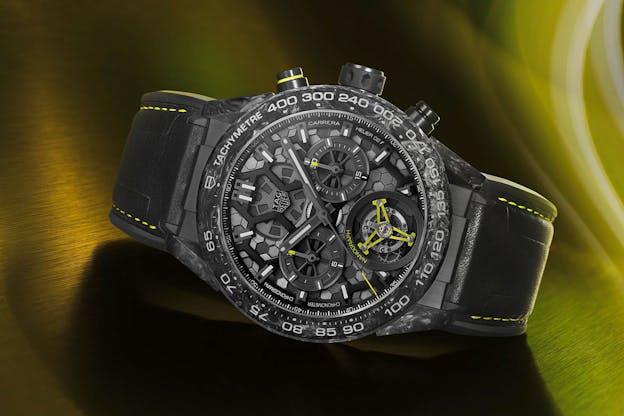The Antimagnetic Watch: How High Tech Materials Conquered One Of Watchmaking’s Greatest Problems
Magnetic fields can stop a watch dead in its tracks. Here’s how the watch industry fought back – and won.
The effects of magnetic fields on mechanical watches can range from subtle and insidious, to immediate and catastrophic. A strong enough magnetic field can stop a movement outright, or instantly cause it to begin keeping extremely erratic time, and magnetic fields can also alter the temperature compensating properties of modern alloy balance springs.
Watch balance springs were made of carbon steel, usually heat tempered blue, for most of the history of watchmaking, and the material is naturally prone to becoming magnetized – in the absence of industrial sources of strong magnetic fields, not enough to stop a watch, but enough to disrupt precision. As the 20th century progressed, however, magnetic fields from human sources became more powerful and more pervasive; the magnetic fields produced by electric motors, starting systems for internal combustion engines, were responsible for the first generation of series produced watches which were specifically designed to resist contamination by magnetic fields.
The Evolution Of Antimagnetic Watch Materials
The poster child for antimagnetic watches in the mid-20th century was the pilot’s watch. These antimagnetic watches coped with the problem of magnetic fields by shielding the movement. The basic method – which is still used by some watch brands today, and which is still effective – was to enclose the movement in a container made of an iron-nickel alloy called “mu-metal.” If you’ve ever read that an antimagnetic watch has a “soft iron” inner case, that’s the material in question.
Usually, the mu-metal container consists of an inner case for the movement, and a dial made of the same material. A soft iron inner case doesn’t block magnetic fields per se – instead, it provides a preferred pathway for magnetic field lines, so the magnetic field flows around the movement rather than flowing through it.

A better system would be one in which the components inside the watch are not affected by magnetism in the first place. Starting in the 1930s, the first generation of iron-nickel balance springs began to find their way into watches, under the trade name Nivarox (Nivarox was developed by Reinhard Straumann, in Switzerland, and the name stands for nicht variabel oxydfest (“non-variable, non-oxidizing”). Nivarox is not completely amagnetic, but it was an improvement over plain tempered steel.
Prior to the introduction of Nivarox, watchmakers experimented with other non-magnetic balance spring materials, including gold, glass, wood, and palladium, which Vacheron Constantin used in a pocket watch in 1915. None of these materials were widely adopted, for various reasons – palladium was costly and hard to machine; wood changes elasticity and dimensions with variations in humidity, gold is harder to harden to a spring temper and glass is … well, glass is glass. Of these materials gold seems to have been the most successful – the Dutch watchmaker Urban Jurgensen was a strong advocate for using them in marine chronometers – but they were never common and the development of Nivarox-type alloys made all of these alternatives obsolete.
IWC And The Ingenieur 500,000 A/m
One of the most impressive early examples of an attempt to create a watch with a balance spring unaffected by magnetism was the development of an IWC Ingenieur model which was capable of resisting magnetic fields up to at least 500,000 A/m. A/m stands for amperes per meter, and 500,000 A/m is equal to about 6300 gauss – which is in the range of the permanent magnets used in MRI machines. The IWC Ingenieur 500,000 A/m came out in the late 1980s – it was a small watch, about 34mm in diameter but it was the biggest deal in the watch world when it came to resisting magnetic fields.

The secret to its success was also the reason for its commercial failure. The balance spring of the movement was made from an alloy of niobium and zirconium, and IWC struggled to get the alloy to perform consistently with respect to temperature compensation. The result was an extremely high rejection rate, and I’ve read that IWC lost money on every watch they produced. The alloy finally began to appear in series produced watches when Rolex managed to solve the production challenges involved in working with the alloy, and debuted its Parachrom balance spring in 2000.
Silicon, The Ultimate Antimagnetic Material
In watchmaking today, the single most widely used solution is silicon for escapement components, including balance springs. Silicon balance springs are sometimes paired with other silicon escapement components, including silicon levers and escape wheels; it can also be paired with other non-magnetic alloys. One common non-magnetic, non-silicon material is a nickel phosphorus alloy, which is fabricated using LIGA. LIGA is a german acronym standing for Lithographie (LI) Galvanoformung (G) Abformung (A). In English that’s lithography, electroforming, moulding, a combination of three microfabrication techniques. Components made from this material are made in Switzerland by Mimotec, which the Federation Of The Swiss Watch Industry reported, in 2020, was making around 15% of the lever and escape wheel components in the industry.

LIGA-fabricated nickel-phosphorus, and silicon components, are what allow companies using the Master Chronometer standard to create watches meeting the standard’s requirement of resistance to magnetic fields at least as strong as 15,000 gauss. We can regard the problem of magnetism as solved in modern watchmaking, for all intents and purposes.
Several years ago, Swatch Group and Audemars Piguet jointly announced the development of a new titanium-based alloy called Nivachron, although it’s not clear whether and when Nivachron balances might become more widely used. A company called Carbontime introduced a carbon fiber balance spring in 2006 which was never commercially produced, and TAG Heuer announced that it had developed a carbon composite balance spring in 2019.
Who Really Needs An Antimagnetic Watch?
There are a couple of questions which arise when considering these materials. The first is the degree to which resistance to such extreme magnetic fields is even necessary; most of us will spend our lives never encountering anything nearly as powerful as a 15,000 gauss field. It’s worth remembering though, that magnetic pollution capable of upsetting timekeeping doesn’t need to be anywhere near that strong to have an effect, even on Nivarox type alloys. Related to this issue is the fact that powerful permanent magnets have become ubiquitous in consumer goods – they’re used to hold phones in place on chargers and they can be found almost universally in laptops, where they help keep the cover shut. In fact, far from being an abstract problem, magnetisms is probably a bigger real problem today than at any other time in the history of watchmaking.

The second question is one of craft. For a certain kind of watch enthusiast, there is something much more romantic about doing things the hard way, and people of that persuasion (I’m one of them, at least partly) feel as if things started to go downhill when we stopped using cut, bimetallic compensation balances and plain steel balance springs. This is of course a totally irrational position, although it is true that traditional crafts are worth preserving – we still want our costly time-only watches from independents to have hand finished movements, after all. But that ship sailed a long time ago – in fact, since the 1920s all the biggest advances in precision have been advances in precision fabrication and advances in materials science. A watchmaker at his bench can’t make a silicon balance spring? Okay, but a watchmaker at his bench can’t make a Nivarox alloy balance spring either.
Since silicon and LIGA fabricated compnents aren’t going anywhere, we might as well celebrate them for what they bring to the table. They aren’t ideal materials in some other respects, but if studying the evolution of watchmaking teaches you anything, it’s that there’s no such thing as an ideal material. At the very least, we live in a magical time when you can work on the Large Hadron Collider without worrying about your watch getting magnetized.
Frequently Asked Questions About Antimagnetic Watches
- What is an antimagnetic watch?
An antimagnetic watch is designed to resist the effects of magnetic fields, which can disrupt or stop a mechanical movement. These watches use special materials or shielding to maintain accurate timekeeping. - How do antimagnetic watches work?
They work by either enclosing the movement in a magnetic shielding case (usually soft iron) or using amagnetic materials like silicon or Nivachron in the escapement and balance spring. - What materials are used in antimagnetic watches?
Common antimagnetic materials include Nivachron (a titanium alloy), silicon, niobium-zirconium alloys, and nickel-phosphorus components fabricated via LIGA microengineering. - Which brands make the best antimagnetic watches?
Leading brands include Omega (Master Chronometer certified), Rolex Milgauss (Parachrom hairspring), IWC (Ingenieur), and TAG Heuer (carbon nanofiber balance springs). - Is Nivachron better than silicon?
Nivachron and silicon both offer strong resistance to magnetism. Silicon offers high precision and lightweight performance, while Nivachron adds thermal stability and is easier to mass-produce. - Do I need an antimagnetic watch?
If you’re regularly around electronics, magnets, or medical equipment like MRI machines, an antimagnetic watch can protect your timepiece from losing accuracy or stopping altogether. - What is the magnetic resistance standard for watches?
The ISO 764 standard defines a magnetic-resistant watch as one that can resist fields up to 60 gauss. Master Chronometer watches resist up to 15,000 gauss or more.

